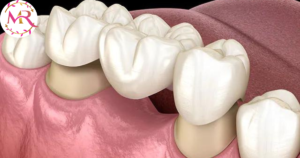What are the Causes of Crown or Bridge Dislodgement?
Discovering the factors that may lead to the dislodgement of a crown or bridge from its supporting tooth is crucial for preventing such incidents and ensuring continued oral health. By understanding these causes, individuals can take proactive steps to safeguard their dental investments.
1-Improper Crown Fit: One of the primary reasons for crown dislodgement is an improper fit between the crown and the prepared tooth. If the crown is not fabricated accurately or does not fit snugly onto the tooth, it may become loose over time and eventually detach.
2-Cement Degradation: The cement used to bond the crown to the tooth may degrade over time due to factors such as wear and tear, saliva exposure, and bacterial infiltration. As the cement weakens, the crown becomes susceptible to dislodgement.
3-Teeth Grinding (Bruxism): Individuals who grind or clench their teeth, a condition known as bruxism, are at an increased risk of crown dislodgement. The excessive forces exerted during tooth grinding can loosen the crown and compromise its stability over time, particularly in the case of posterior crowns.
4-Recurrent Caries: Decays or cavities that develop underneath the crown can weaken the tooth’s structure and compromise the integrity of the restoration. If left untreated, recurrent caries can cause the crown to loosen and eventually detach from the tooth.

What are the consequences of delaying Recementation?
Delaying crown recementation can have significant repercussions on oral health and overall wellbeing. Here are some potential consequences of postponing this essential dental procedure:
1-Risk of Tooth Weakness and Fracture: A dislodged crown leaves the underlying tooth vulnerable to fractures, especially during chewing and biting. Without the protective covering of the crown, the tooth may experience increased stress and become susceptible to structural damage.
2-Potential for Over-Eruption: In the absence of the crown, the prepared tooth and its opposing teeth may undergo unwanted shifts in position.
3-Need for Replacement: If crown recementation is delayed for an extended period, the condition of the tooth and the surrounding tissues may deteriorate further.
What is crown Recementation and how is it done?
1-Crown Recementation: When a crown becomes dislodged from its supporting tooth, prompt action is essential to ensure proper restoration. Crown recementation, also known as crown reattachment, is the process of securely reattaching the crown to its original position. This procedure involves several meticulous steps to achieve optimal results:
2-Proper Isolation: Before beginning the recementation process, the dentist ensures proper isolation of the affected tooth to maintain a clean and dry environment. This step is crucial for preventing contamination and promoting effective bonding between the crown and the tooth.
3-Choosing the Right Cement: The selection of an appropriate cement is critical for successful crown recementation. The dentist carefully evaluates these factors to determine the most suitable cement for optimal adhesion.
4-Applying the Cement: Once the tooth is isolated and the cement is selected, the dentist applies the cement to the internal surface of the crown or bridge. Precision is key during this step to ensure uniform coverage and proper distribution of the cement. The crown is then carefully positioned on the prepared tooth, and any excess cement is removed.
5-Light Curing: After the crown is placed in its correct position, a curing light is used to activate the cement and facilitate its setting process. This light-curing technique helps ensure a strong and durable bond between the crown and the tooth.
1. Modification of Crown or Tooth
2. Fabrication of a New Crown
By promptly seeking professional assistance from your dentist, you can mitigate these risks and ensure the appropriate steps are taken to preserve your dental health and restore the functionality of your tooth.
Doctor of Medicine, Constantine University, Algeria
Diploma in Dermatology, Plymouth University, UK
Certified from the American Academy for Anti-Ageing and Aesthetic Medicine:
Lasers, Advanced Injectables, Threads ,Chemical Peeling